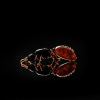Nope. It's a wasp. Family Mutilidae.
well wtf why is it called a velvet ant then, why not a velvet wasp
Because some ignorant people saw it and called it an ant.
Haha, ya, spot on.

Nope. It's a wasp. Family Mutilidae.
well wtf why is it called a velvet ant then, why not a velvet wasp
Because some ignorant people saw it and called it an ant.
Haha, ya, spot on.
I accidentally froze all my ants
President & founder of LHS Entomology Club, (available on discord) Check out my photography website! https://www.armyofinsects.com/ Email me with questions
at jk@uglyorangetruck.com (funny email, I know)
President & founder of LHS Entomology Club, (available on discord) Check out my photography website! https://www.armyofinsects.com/ Email me with questions
at jk@uglyorangetruck.com (funny email, I know)
Were they all successful?
Dorymyrmex bicolor. Hands down, best species ever. Amazing. Dorymyrmex = gold.
Very close runner up would no doubt be Solenopsis. It's why Ants Canada makes so many videos on them. Especially Solenopsis invicta. Very rare. Absolutely beautiful. Even if you are within the quarantined RIFA zone, they are extremely hard to find. Best of lucking purchasing one because every time they go up for sale (at an astounding $5 - who has that kind of money in this economy?!?!), buyers immediately scoop them up and they are out of stock within milliseconds.
Edited by nurbs, December 7 2017 - 9:55 PM.
Instagram:
nurbsants
YouTube
California Ants for Sale
Unidentified Myrmecocystus
https://www.formicul...ls-near-desert/
Undescribed "Modoc"
https://www.formicul...mp-ca-5-4-2017/
Camponotus or Colobopsis yogi:
https://www.formicul...a-ca-1-28-2018/
Camponotus us-ca02
https://www.formicul...onotus-us-ca02/
Unidentified Formica
https://www.formicul...l-ca-6-27-2020/
Pencil Case and Test Tube Formicariums
https://www.formicul...m-and-outworld/
Bloodworm Soup
https://www.formicul...bloodworm-soup/
Dorymyrmex bicolor. Hands down, best species ever. Amazing. Dorymyrmex = gold.
Very close runner up would no doubt be Solenopsis. It's why Ants Canada makes so many videos on them. Especially Solenopsis invicta. Very rare. Absolutely beautiful. Even if you are within the quarantined RIFA zone, they are extremely hard to find. Best of lucking purchasing one because every time they go up for sale (at an astounding $5 - who has that kind of money in this economy?!?!), buyers immediately scoop them up and they are out of stock within milliseconds.
![]() I sense no sarcasm at all.
I sense no sarcasm at all.
Aren't his vids about Solenopsis geminata? In truth, I like them even though they're everywhere back in Hawaii. They were my first ants.
Well technically they are native to the US.
Southern US.
and Hawaii is part of the US.
So technically they are native to Hawaii?
TL;DR They are native to the US.*
My parasitic ants were introduced using my parisitim tecnique. I put the ants in a freezer for 2 mins and 30 secs and then simply introduce both in a bin. i also include a dead worker from the host colony in the queen tube.
President & founder of LHS Entomology Club, (available on discord) Check out my photography website! https://www.armyofinsects.com/ Email me with questions
at jk@uglyorangetruck.com (funny email, I know)
Resolved.
Edited by Connectimyrmex, December 10 2017 - 5:21 PM.
My parasitic ants were introduced using my parisitim tecnique. I put the ants in a freezer for 2 mins and 30 secs and then simply introduce both in a bin. i also include a dead worker from the host colony in the queen tube.
Were the colonies successful? If you ACTUALLY raised Lasius claviger or any other Acanthomyops, you should be famous (Only one person on this forum has ever gotten a worker from Lasius claviger). Cthonolasius isn't actually especially hard to rear, even a semi-newb ant keeper like me managed to get one worker from a Lasius alienus x Lasius umbratus colony. The queen died soon after, though.
S. geminata is native to the South Eastern portions of the US. the bulk of its native range is in the Southeastern US, Mexico and Central America where its role as a seed harvester often brings it into conflict with various Pheidole sp. The range of S. geminata reaches as far west as Arizona and as South to central South America. That being said it's an invasive that has established itself in many parts of the world, mostly in South eastern Asia and the pacific as a whole including Oceana. The only US state that has S. geminata as an invasive is Hawaii, (although they probably could have spread elsewhere to neighbouring states they are found in). The rest of S. geminata's range in the US is more or less native.
Edited by LC3, December 10 2017 - 4:03 PM.
All the books I've read stated that Solenopsis geminata was an asian species. Guess you're right, though.
EDIT: I just read Antweb's entry, and now I believe you even more.
Edited by Connectimyrmex, December 10 2017 - 5:21 PM.
the technique is not uncommon, i found it in a myrmecology journal from 1974. I don't rememeber which one. Sometimes I have to clip the antennae of the host ants.
i only do this to one. and i only clip a tiny bit.
President & founder of LHS Entomology Club, (available on discord) Check out my photography website! https://www.armyofinsects.com/ Email me with questions
at jk@uglyorangetruck.com (funny email, I know)
S. geminata is not native, it's established.
President & founder of LHS Entomology Club, (available on discord) Check out my photography website! https://www.armyofinsects.com/ Email me with questions
at jk@uglyorangetruck.com (funny email, I know)
the reason i released the queens is because i am terrible at rearing up the workers. they often get up to 8 brood and then tear the pupae apart. even when they had workers they did this.
President & founder of LHS Entomology Club, (available on discord) Check out my photography website! https://www.armyofinsects.com/ Email me with questions
at jk@uglyorangetruck.com (funny email, I know)
S. geminata is not native, it's established.
Wait, I was right?
yes, to be native something has to inhabit a landmass for at least 35 years, and many ecologist only call something native if it adapts to it's environment, in the sense that the species has a unique adaption compared to the country(s) of origin.
President & founder of LHS Entomology Club, (available on discord) Check out my photography website! https://www.armyofinsects.com/ Email me with questions
at jk@uglyorangetruck.com (funny email, I know)
yes, to be native something has to inhabit a landmass for at least 35 years, and many ecologist only call something native if it adapts to it's environment, in the sense that the species has a unique adaption compared to the country(s) of origin.
I know what it means to be native. I've been an entomologist/biologist my whole life.
I was wondering where it was native to. LC3 stated that they were native to the United States and were introduced to Asia, along with the Antweb files.
Dasymutilla isn't even an ant.
yes it is
You just made me tactical facepalm.
Ant Keeping →
Ant Keeping Journals →
Amatty’s Perfect Prociliata (Best NA Formica Parasite)Started by Amatty76 , Jun 17 2023 |
|

|
0 members, 1 guests, 0 anonymous users